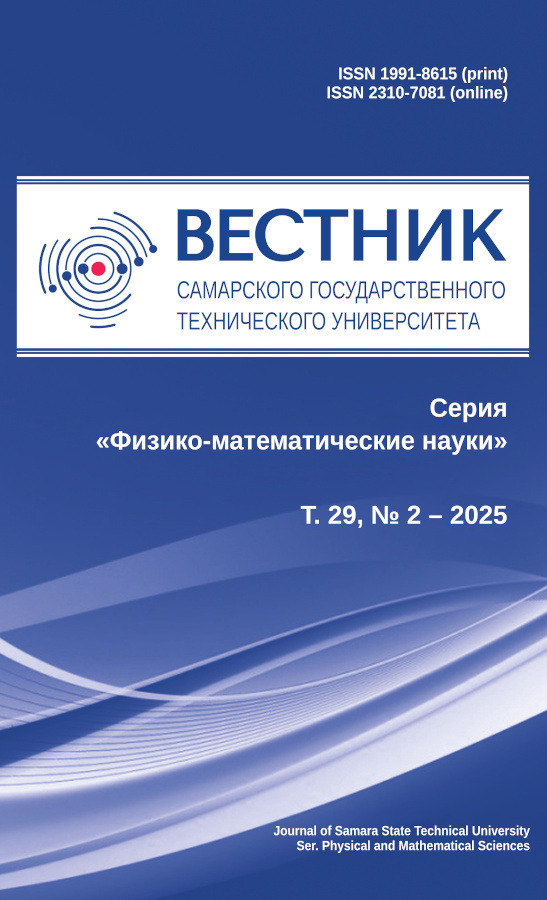Determination of dynamic modes in a two-mode hereditary dynamo system
- Authors: Kazakov E.A.1, Vodinchar G.M.1
-
Affiliations:
- Institute of Cosmophysical Researches and Radio Wave Propagation, Far East Division, Russian Academy of Sciences
- Issue: Vol 29, No 2 (2025)
- Pages: 319-333
- Section: Mathematical Modeling, Numerical Methods and Software Complexes
- URL: https://journal-vniispk.ru/1991-8615/article/view/349673
- DOI: https://doi.org/10.14498/vsgtu2130
- EDN: https://elibrary.ru/LWBCIR
- ID: 349673
Cite item
Full Text
Abstract
This study presents a computational analysis of a hereditary dynamical system modeling a two-mode hydromagnetic dynamo with memory. We conduct a numerical investigation of dynamic regimes emerging under variation of the system’s control parameters. The hereditary dynamical system is described by a set of integro-differential equations.
Lyapunov exponent analysis serves as a principal method for examining dynamic regimes. To implement this approach, the integro-differential system was reduced to a system of ordinary differential equations. The paper provides a description of the corresponding class of kernels and the reduction result.
As an alternative approach, we employ the 0-1 test for chaos detection. A comparative analysis between the 0-1 test and Lyapunov exponents for a particular case demonstrates their qualitative agreement. Subsequent investigations are primarily utilized the 0-1 test for analyzing the integro-differential system’s dynamic regimes.
Notably, this method only discriminates between regular (periodic and asymptotically stationary) and chaotic regimes. For finer classification of regular regimes, we propose an auxiliary method based on analyzing the autocorrelation function characteristics of the solution’s time series. Empirical results show that computing the autocorrelation function’s expected value effectively distinguishes periodic/quasi-periodic regimes from asymptotically stationary ones.
Both instantaneous and delayed hereditary feedback cases are examined. Simulation results reveal that the model reproduces various dynamic regimes characteristic of actual cosmic dynamo systems.
Full Text
##article.viewOnOriginalSite##About the authors
Evgeny A. Kazakov
Institute of Cosmophysical Researches and Radio Wave Propagation, Far East Division, Russian Academy of Sciences
Email: kazakov@ikir.ru
ORCID iD: 0000-0001-7235-4148
SPIN-code: 3564-6783
Scopus Author ID: 57204824921
https://www.mathnet.ru/rus/person129133
Junior Researcher; Lab. of Electromagnetic Propogation
Russian Federation, 684034, Kamchatkiy kray, Paratunka, Mirnaya str., 7Gleb M. Vodinchar
Institute of Cosmophysical Researches and Radio Wave Propagation, Far East Division, Russian Academy of Sciences
Author for correspondence.
Email: vodinchar@ikir.ru
ORCID iD: 0000-0002-5516-1931
SPIN-code: 2079-6494
Scopus Author ID: 56514066300
ResearcherId: F-4653-2017
https://www.mathnet.ru/rus/person32636
Cand. Phys. & Math. Sci., Associate Professor; Leading Researcher; Lab. Simulation of Physical Processes
Russian Federation, 684034, Kamchatkiy kray, Paratunka, Mirnaya str., 7References
- Zel’dovich Ya. B., Ruzmaikin A. A., Sokolov D. D. Magnitnyye polya v astrofizike [ Magnetic Fields in Astrophysics]. Moscow, Izhevsk, Regular and Chaotic Dynamics, 2006, 436 pp. (In Russian)
- Krause F., Rädler K.-H. Mean-Field Magnetohydrodynamics and Dynamo Theory. New York, Pergamon Press, 1980, 271 p. DOI: https://doi.org/10.1016/C2013-0-03269-0.
- Merril R. T., McElhinny M. W., McFadden P. L. The Magnetic Field of the Earth: Paleomagnetism, the Core, and the Deep Mantle, International Geophysics, vol. 63. London, Academic Press, 1996, xiv+531 pp.
- Brandenburg A. Memory effects in turbulent transport, Astrophys. J, 2009, vol. 706, no. 1, pp. 712–726. DOI: https://doi.org/10.1088/0004-637x/706/1/712.
- Hori K., Yoshida S. Non-local memory effects of the electromotive force by fluid motion with helicity and two-dimensional periodicity, Geophys. Astrophys. Fluid Dyn., 2008, vol. 102, no. 6, pp. 601–632. DOI: https://doi.org/10.1080/03091920802260466.
- Vodinchar G. Hereditary oscillator associated with the model of a large-scale $alphaomega$-dynamo, Mathematics, 2020, vol. 8, no. 11, 2065. DOI: https://doi.org/10.3390/math8112065.
- Kazakov E. A. Hereditary low-mode dynamo model, Vestnik KRAUNC. Fiz.-Mat. Nauki, 2021, vol. 35, no. 2, pp. 40–47 (In Russian). EDN: RDPQER. DOI: https://doi.org/10.26117/2079-6641-2021-35-2-40-47.
- Kazakov E. A. Two-mode model of a hydromagnetic dynamo with memory, Comput. Technol., 2022, vol. 27, no. 6, pp. 19–32 (In Russian). DOI: https://doi.org/10.25743/ICT.2022.27.6.003.
- Gottwald G. A., Melbourne I. The 0–1 test for chaos: A review, In: Chaos Detection and Predictability, Lecture Notes in Physics, 915. Berlin, Heidelberg, Springer, pp. 221–247. DOI: https://doi.org/10.1007/978-3-662-48410-4_7.
- Vodinchar G. M., Kazakov E. A. Elimination of the integral term in the equations of one hereditary system related to the hydromagnetic dynamo, Vestnik KRAUNC. Fiz.-Mat. Nauki, 2023, vol. 42, no. 1, pp. 180–190. EDN: BRDBZK. DOI: https://doi.org/10.26117/2079-6641-2023-42-1-180-190.
- Vodinchar G., Kazakov E. The Lorenz system and its generalizations as dynamo models with memory, E3S Web Conf., 2018, vol. 62, 02011. EDN: HUZOAB. DOI: https://doi.org/10.1051/e3sconf/20186202011.
- Barbashin E. A. Funktsii Lyapunova [Lyapunov Functions], Physico-Mathematical Heritage: Mathematics (Theory of Differential Equations). Moscow, URSS, 2012, 246 pp. EDN: QKAKBH.
- Bathe K.-J., Wilson E. L. Numerical Methods in Finite Element Analysis, Prentice-Hall Civil Engineering and Engineering Mechanics Series. Englewood Cliffs, N.J., Prentice-Hall, 1976, xv+528 pp.
- Benettin G., Galgani L., Giorgilli A., Strelcyn J. M. Lyapunov Characteristic Exponents for smooth dynamical systems and for hamiltonian systems; a method for computing all of them. Part 1: Theory, Meccanica, 1980, vol. 15, no. 1, pp. 9–20. DOI: https://doi.org/10.1007/bf02128236.
- Benettin G., Galgani L., Giorgilli A., Strelcyn J. M. Lyapunov characteristic exponents for smooth dynamical systems and for hamiltonian systems: A method for computing all of them. Part II: Numerical application, Meccanica, 1980, vol. 15, no. 1, pp. 21–30. DOI: https://doi.org/10.1007/BF02128237.
- Sergienko A. B. Tsifrovaya obrabotka signalov [Digital Signal Processing]. St. Petersburg, BHV-Petersburg, 2011, 768 pp. (In Russian)
- Uchaykin V. V. Metod drobnykh proizvodnykh [The Method of Fractional Derivatives]. Ulyanovsk, Artishok, 2008, 510 pp. (In Russian). EDN: QJVANP.
- Parovik R. I. Chaotic regimes of a fractal nonlinear oscillator, Vestn. Samar. Gos. Tekhn. Univ., Ser. Fiz.-Mat. Nauki [J. Samara State Tech. Univ., Ser. Phys. Math. Sci.], 2018, vol. 22, no. 2, pp. 364–379 (In Russian). EDN: UXHTLO. DOI: https://doi.org/10.14498/vsgtu1611.
Supplementary files














